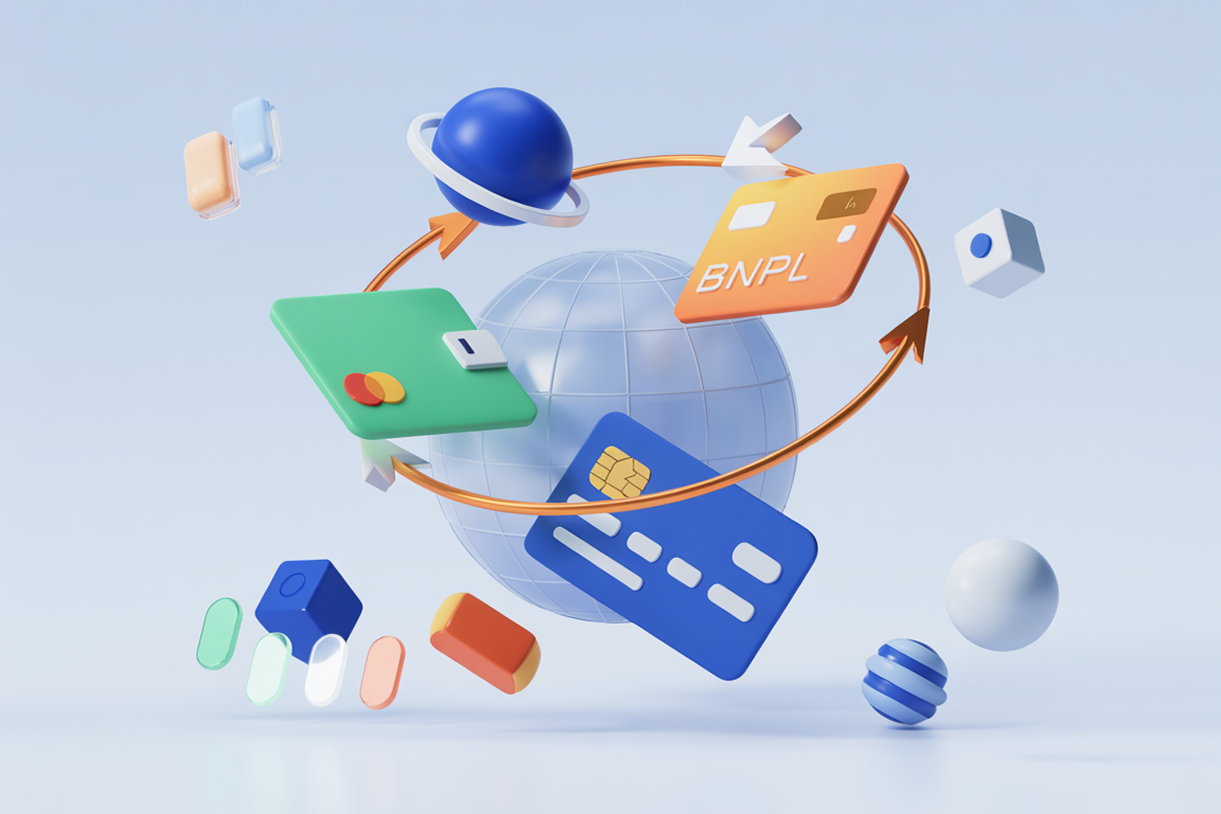Why businesses need multiple payment options
Discover the importance of multiple payment gateways for boosting sales and enhancing customer experience.

Jeff Bezos once said: “we see our customers as invited guests to a party, and we are the hosts. It’s our job every day to make every important aspect of the customer experience a little bit better”. And on top of offering great customer service and attractive prices, there’s hardly anything that will affect your sales as strongly as offering a flawless purchasing experience.
But what does ‘flawless’ mean? In the context of closing sales, it’s mostly about giving choice and letting clients use their preferred ways to pay. In this article, we’re going to tell you why you should use multiple payment gateways and what options you have.
Why is it important to have many payment options?
Offering multiple payment options benefits both sides – not only customers but also business owners. Here’s how:
Higher conversion rate and lower cart abandonment
Ever been in a situation where you searched for a specific product, found a site that offered it at the best price, and added it to a basket only to find out that you can’t pay using your preferred payment method? I have!
When I travel I usually rent a car. While there are plenty of rental companies, very few offer the option to either pay with cash or a debit card – the majority require credit cards. It’s a problematic situation for a person like myself who doesn’t own a credit card. It usually takes me a while to find a company that offers multiple payment methods, which negatively impacts my shopping experience. Whenever I find one that does, I stick with it for my future trips.
What’s the learning? Offer your customers a few payment gateways to select from to lower the cart abandonment rate and boost conversion.
Better customer experience
Customers have different payment preferences, which usually depend on their origin and age. For example, people in the Netherlands and Denmark prefer debit cards, while younger consumers turn to mobile payment apps. And, speaking of mobile, plenty of people like to shop on the go, for example, while commuting to work. As they can pay through a mobile device, they don’t have to wait until they get home and log onto a computer to finalize their purchase. They can now do it with a single click.
To be able to cater to a wider target audience, you should accept multiple payment methods. Reducing friction and enhancing convenience in the purchasing process will positively impact the shopper experience and customer loyalty.
Brand trust
Giving your customers the option to pay through a trusted payment gateway gives your brand credibility. When someone enters their credit card data or logs into an online banking system, they want to know that the whole online payment process is protected through a professional operator, which offers the right SSL certificates and encryption.
This can be particularly important if you’re a new creator or online business – if a client sees those familiar payment method icons in the checkout process, they are more likely to convert.
Speaking of familiarity, this leads to the next benefit.
Global reach
When it comes to selling digital products, the term “multiple payments” can also mean “_international_”. People now love buying from brands all over the globe – by 2027, the cross-border payment market will reach a value of $250 trillion, which is a $100 trillion growth in just ten years! So, unless you’re selling a super-localized product like ebooks on “navigating income tax in Canada”, you should consider using a platform that allows you to collect payments globally.
Lower financial risks for you as a creator
This is probably the least obvious benefit, but an incredibly important one. When you offer customers the option to pay through numerous methods, you don’t leave all your money in the hands of a single third-party provider. This means you also minimize risks like fraud, chargebacks, or long payout periods.
To give you a real-life example of why this matters, a creator I know told me once that a freelancing marketplace she used kept all her earnings for 45 days before releasing payment. Using multiple payment gateways means keeping cash flow issues at bay.
What are the different payment methods I could offer?
The exact choices should depend on the market – or markets – you sell on, but here are the most common ones:
- Credit and debit cards – card payment is the most universal method; everyone buying online has a debit and/or credit card. Some even decide to save their card details for future payments, like new product purchases or recurring transactions like subscriptions.
- **Digital wallets **– this is a very broad category, which includes services like Stripe, PayPal, and Revolut, as well as mobile options like Google Pay and Venmo. Some people choose digital wallets because they’re very convenient to use, for example, by adding them as a tap-and-go payment method on their phones or smartwatches. Other digital wallets lure customers with unbeatable conversion rates, which comes in handy when buying online from foreign brands.
- **Online banking/bank transfers – another popular payment solution. When a customer chooses this option, they’re redirected from the cart to their bank, where they can safely log in, issue payment for the purchase, and automatically log out. **
- Gift cards/vouchers – vouchers are an indirect form of payment, as you pay for a unique code that holds a specific value. A lot of retailers offer them either as gift cards or as a way to reimburse for a returned item. Even if they don’t make your list for the first version of your store, we suggest adding them in the future. The voucher market is growing at 23.7% year over year, so your clients will probably keep asking for them.
- Installments and delayed payment schemes – finally, many customers appreciate the option to break down payments or postpone the due date. Offering this can be especially useful if you’re selling high-end products or services, or if your clients tend to have a high cart value. They’re more likely to finalize the order if they don’t have to release all the money upfront! A good example is Klarna, which lets online shoppers purchase products and pay in four installments.
- How many payment options should I offer?
- Unfortunately, there is no definitive answer to this question. But, since people have different preferences, it’s worth catering to them. For example, according to the Federal Reserve, 29% of customers favor debit cards, 28% credit cards, 20% cash, and 11% direct payments. The remaining 12% is for alternative payment methods.
Bear in mind that offering too many payment options might backfire and lead to higher cart abandonment as consumers won’t know which option to pick and might leave the ecommerce store. It’s best to do a little research to find the preferred payment methods and hold on to these.
What will happen if I don’t offer enough payment methods?
Unless you’re a pioneer in something, customers will have other options to choose from. And they will not only look for a store that offers the best price but also a certain payment method. If they want to pay using Google Pay, and your online store doesn’t allow it, they will shop elsewhere. This means a lost sale and a potential negative review.
According to PayPal, a lack of multiple payment options at checkout is one of the most common reasons why customers fail to complete their purchases – with 59% of respondents admitting to abandoning their cart if their preferred payment method is not available.
Customers might return to your store, not just because they like your products, but also because they can pay in a way they like. Jeff Finkelstein, Founder of Customer Paradigm, says: “there are certain places I like to buy from because they take PayPal and it makes it super-easy for me to pay that way. If you’re in an industry where customers have lots of choice from where they can buy, adding additional payment methods allows you to not turn away a customer”.
Also, don’t forget that it’s not ‘just’ about the customer’s perspective; not offering multiple payment options also poses an operational risk for you. Here’s a cautionary tale.
Be careful about the option you choose – we learned the hard way
A while back, I worked as a content creator for a US-based design software company. When I agreed on the terms of our cooperation, they told me that they only used one payment method, one of the world’s most-known digital wallets, while working with international contractors.
In the past, I used a similar digital wallet to receive payment from a client in Singapore and everything went smoothly, so I agreed. My only cost for using that payment gateway was a 1–2 % commission rate, which I could accept.
So, I went on and delivered the first project, issued an invoice, and waited for the transfer. Little did I know, the minute the customer transferred the payment in USD, I saw that the money was automatically frozen for three weeks on the account. When I reached out to customer support, they told me it was because it was the first payment I ever _received _to the account.
It didn’t matter that I paid through this channel multiple times myself and underwent all the necessary anti-fraud verifications. So, before the money became available to me, I had to pay income tax for it right from my savings. Ouch.
Then, once I could finally transfer the money from the digital wallet to my bank account, I learned that I could not run a USD → USD transfer, even though I had a dollar bank account. The digital wallet forced me to convert the money for a very hefty fee. Ouch number two.
I’m sure I don’t have to tell you that I blacklisted this payment method once and for all, despite its global popularity, and will never work with a company that can only use this tool.
Tip: Make sure to verify payment conditions before selecting a specific payment gateway to avoid unpleasant surprises.
Offer multiple payment methods with Easycart
Easycart is the best way to offer multiple payment options without building complex integrations or creating a lengthy customer checkout flow. It’s as easy as creating a one-step checkout page, and adding the product information and payment options.
You can also offer multiple currencies via Easycart. Giving clients the option to choose their preferred payment option also lets them select the ones where they have the most favorable conversion rates or where they have money in the currency.
Finalizing online sales has never been this easy – create your first checkout page and see for yourself.
Related articles
Ready for more? Check out these related articles that will keep your momentum going. They’re packed with easy-to-follow tips and tricks to help you supercharge your digital goods business.
Take it easy with Easytools
Focus on creating, and let Easytools handle the behind the scenes work.





